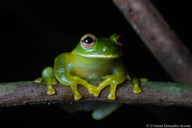|
Ikakogi tayrona (Ruiz-Carranza & Lynch, 1991)
Magdalena Giant Glass Frog | family: Centrolenidae subfamily: Centroleninae genus: Ikakogi |
 © 2023 Cristian Gonzalez Acosta (1 of 6) |
|
|
|
Description Ikakogi tayrona can be identified by the following combination of characters: 1) vomerine dentition absent, 2) bones white in life, 3) color in life green to pale green, 4) snout rounded when viewed dorsally, sloped and truncated when viewed laterally, 5) skin is dorsally granular, 6) ulnar and tarsal folds small, 7) males have a large humeral spine. Adult females reach 28.2-30.8mm SVL, males reach 28.2-30.6mm SVL. Head as wide as body, but wider than long (head width 34.8-38.7 % SVL). Nostril-eye distance is 52.8-83.9 % eye width. Nostrils protuberant and oriented anterolaterally. Eyes not visible around border of snout when viewed ventrally. Supratympanic fold thick and very well defined. Vomerine dentition absent. Length of tibia is 51.9-58.6 % SVL. Distribution and Habitat Country distribution from AmphibiaWeb's database: Colombia
Life History, Abundance, Activity, and Special Behaviors Possible reasons for amphibian decline General habitat alteration and loss
References
Duellman, W.E. (1979). ''The herpetofauna of the Andes: patterns of distribution, origin, differentiation, and present communities.'' The South American Herpetofauna: Its Origin, Evolution, and Dispersal. W.E. Duellman, eds., Monographs of the Museum of Natural History, University of Kansas, 7: 371-459. Lynch, J.D. (1981). ''The idnetity of Hylopsis platychephala Werner, a centrolenid frog from northern Colombia.'' Journal of Herpetology, (15), 283-291. McDiarmid, R.W. and Savage, J.M. (1984). ''Taxonomic status of the frog genus Centrolenella Noble (Anura: Centrolenidae).'' Journal of Herpetology, (18), 213-215. Ruiz-Carranza, P.M. and Lynch, J.D. (1991). ''Ranas Centrolenidae de Colombia II: Nuevas especies de Centrolene de la Cordillera Oriental y Sierra Nevada de Santa Marta.'' Lozania, (58), 1-26. Valencia, LB and Delia, J (2016). ''Maternal care in a glassfrog: care function and commitment to offspring in Ikakogi tayrona.'' Behavioral Ecology and Sociobiology, 70(1), 41-48. Werner, F. (1894). ''Über einige Novitäten der herpetologischen sammlung des Wiener zool. vergl. anatom. Institut Zool. .'' Anzieger, (17), 155-157. Originally submitted by: Raul E. Diaz (first posted 2002-12-22) Distribution by: Michelle S. Koo (updated 2021-03-18)
Life history by: Michelle S. Koo (updated 2021-03-18)
Edited by: Keith Lui, Michelle Koo (2021-03-18) Species Account Citation: AmphibiaWeb 2021 Ikakogi tayrona: Magdalena Giant Glass Frog <https://amphibiaweb.org/species/1747> University of California, Berkeley, CA, USA. Accessed Apr 30, 2025.
Feedback or comments about this page.
Citation: AmphibiaWeb. 2025. <https://amphibiaweb.org> University of California, Berkeley, CA, USA. Accessed 30 Apr 2025. AmphibiaWeb's policy on data use. |



 Map of Life
Map of Life